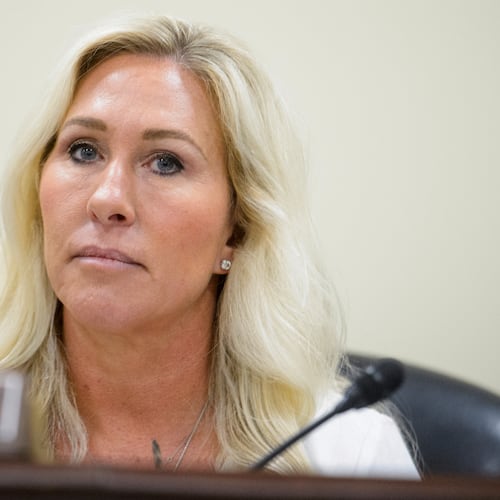The presidential candidates have left town, the wave of ads will soon subside and the polls are still as close as ever. And soon voters will know whether Georgia is truly a swing state.
Georgia has emerged as one of the nation’s biggest electoral battlegrounds in the race for the White House, and a handful of factors could determine whether the state stays in the Republican column this year or flips to Democrats for the first time since 1992.
For President Donald Trump’s campaign, Georgia is as close to a must-win state as it gets. He has little path to reelection if he loses the state’s 16 electoral votes, one reason why he staged a Sunday night rally in northwest Georgia.
Democrat Joe Biden has other routes to win the White House if he loses Georgia, but his campaign’s late push here shows he’s aiming for a rout in the closing days of the race. Democrats haven’t won a statewide race in Georgia in a dozen years, but they came tantalizingly close in 2018.
The down-ticket races are as important as ever, with twin U.S. Senate contests that could determine control of the chamber. U.S. Sen. David Perdue and Democrat Jon Ossoff are deadlocked in every recent poll. And U.S. Sen. Kelly Loeffler is knotted up with U.S. Rep. Doug Collins for the right to face Democratic front-runner Raphael Warnock in a January runoff.
Here’s a look at five questions that will help shape the outcome:
Just how blue will Atlanta’s suburbs go?
It’s become one of the most familiar narratives in Georgia politics: In 2016, the once-reliably Republican bastions of Cobb and Gwinnett counties voted Democratic for the first time since Jimmy Carter’s presidency. Since then, they’ve only inched more to the left.
Stacey Abrams, fueled by her strength in the suburbs, almost forced a runoff two years ago in the governor’s race against Brian Kemp. Down-ticket candidates fared better: Lucy McBath defeated Republican U.S. Rep. Karen Handel to win a congressional seat spanning Atlanta’s northern suburbs, and Democrats flipped about a dozen state legislative seats, many in the city’s bedroom communities.
Credit: John Amis
Credit: John Amis
Now the suburbs have become a linchpin of the Democratic strategy in Georgia, as candidates race to win over wavering white women who once voted Republican and also solidify support with Black, Hispanic and Asian voters who have made the territory increasingly diverse.
That’s why vice presidential nominee Kamala Harris went to Gwinnett County on Sunday for a late campaign push. Democrats are trying to reach 60% of the vote in Gwinnett and flip a Republican-held congressional seat.
Republicans on the defensive have tried to broaden their appeal by emphasizing more consensus issues, such as the successful push for a hate-crimes law and legislation to expand health care access for low-income mothers.
Will Republicans resurrect the “beautiful red wall” in Georgia?
Republicans withstood the rush of Democratic energy in Georgia the past two election cycles by winning with even bigger margins in the state’s agricultural heartland. Trump carried much of rural Georgia by whopping margins — and two years later Kemp outdid those margins in many counties.
It was part of a major effort to quietly engage a universe of conservatives who once regularly ignored elections but could be enticed to vote because of Kemp’s support for the president. And Trump’s campaign has raced to resurrect that movement this year.
Credit: Ben Gray
Credit: Ben Gray
“Wait until you see what happens with the great red wave,” Trump told a crowd of thousands massed Sunday in northwest Georgia, a cornerstone of his strategy.
He’s trying to rally his most reliable electoral bloc — conservative white men — to turn out in droves on Election Day. Rebuilding that coalition will help offset Democratic gains in the more populous suburbs, but it’s getting harder for Republicans to expand on already huge margins in those counties.
Take Banks County, a Republican stronghold for decades — no Democrat has even qualified to run for a county-level seat there in years. Trump won Banks with 88% of the vote in 2016; Kemp carried it with 90% two years later.
“Counties from Camden to White are going to be red Tuesday night,” said W. John Wood, a former GOP chair of the Savannah-based 1st Congressional District.
The race, Wood said, will come down to “only about 10 to 20 other competitive counties.”
Conversely, Democrats are scrambling to drive up their vote total even a fraction in rural outposts.
“Let’s say Democrats usually get 20% of the vote in places like where I grew up in Monroe County,” said Seth Clark, a Democratic commissioner-elect in Bibb County. “What happens if they get 22% in those places this time? Well, that’s the ballgame.”
Will Democrats hit 30-30?
In baseball, the 30-30 club is a vaunted group of batters who have hit 30 home runs and stolen 30 bases. For Georgia Democrats, the number takes on a different sort of import.
For most of the past decade, it’s been a key threshold Democrats have ached to reach. “If Democrats can get up to 30% of the white vote, and if Black voters comprise at least 30% of overall turnout, there’s a real chance of statewide Democratic wins,” said Trey Hood, a University of Georgia political scientist.
Credit: TNS
Credit: TNS
In 2016, they didn’t come too close. Exit polls show Hillary Clinton won about 21% of white voters, while Black turnout hit 28%.
Biden could be nearing both those numbers this year. An Atlanta Journal-Constitution poll released last week showed Biden with 28% of the white vote, and several other recent surveys suggest similar outcomes. The rate of African American turnout is harder to project.
So far, turnout by Black voters is lower than their share of the state’s registered voters. An analysis of the state’s record number of early votes shows Black voters account for 28% of votes cast so far; they make up 30% of all registered voters in Georgia.
Higher African American turnout could change the direction of the national race and lead to an anachronistic outcome.
“If noncollege-educated whites turn out for Trump, but Black voters have higher turnout in 2020 than in 2016, Trump could win states in the Rust Belt but lose Georgia,” said Glen Smith, a University of North Georgia political scientist. “I’m not saying it’s likely, but it’s plausible.”
State Democrats aren’t too worried about turnout among Black women, by far the most reliable bloc of left-leaning voters in the state. They’re more concerned with Black men, whom Trump and his allies have aggressively targeted in the closing months of the race.
Fewer than half of Black men registered to vote in Georgia cast a ballot in 2016, compared with about two-thirds of white voters and 63% of Black women.
“There’s a theory out there that the president has to overwhelmingly win with white men to be able to carry the state,” said Martha Zoller, a radio show host and former Republican congressional candidate. “But it’s really all men across the board.”
How will the fight over ballot access affect the vote?
The 2018 race for governor between Abrams and Kemp made Georgia ground zero in a long-running battle over voting rights. In 2020, the fight has only sharpened.
Hours-long lines in June during the primary reminded the nation of deep-seated problems with the elections system, and polling place closures and relocations across the state — along with 1 million new voters since the last presidential election — could strain the fragile system again.
Secretary of State Brad Raffensperger, the state’s top elections official, has warned Georgians to prepare for long lines and cautioned that results in close races might not be clear on election night because of the time it takes to count absentee ballots.
Credit: JOHN SPINK / AJC
Credit: JOHN SPINK / AJC
He’s also stressed improvements to the state’s voting process since the June primary, when an AJC analysis showed about 61% of majority-Black precincts closed on time during the June primary, highlighting where voters faced the longest lines, compared with 80% of mostly white locations.
Democrats worry that the extremely long lines and complications with absentee ballots amount to a tacit form of voter suppression that could prevent ballots from being counted. And both parties are ramping up for more potential legal battles over ballot access, adding to the lawsuits already pending in court.
Abrams, who launched a voting rights group after losing the 2018 election, has urged Georgians to stay calm — and stay in line — no matter what.
“Elections are about math. We can talk about all of the ways you can either add or subtract voters,” she said. “But in a democracy, there should be no attempt at subtraction because of failures in election administration.”
How will the pandemic reshape Georgia’s electorate?
We know this much is true: Georgia will shatter turnout records on Tuesday. The jury is still out on how vastly that will change the state’s electorate.
Thanks to a surge of mail-in ballots triggered by the pandemic, nearly 4 million Georgians cast ballots before Election Day. That’s almost as many as voted during the entire 2016 election — when Georgia had its highest turnout ever.
Nearly one-third of this year’s voters didn’t cast ballots in the last presidential election, and a comparison against voters lists in this spring’s partisan primary indicates more Democratic than Republican voters have turned out so far.
That’s not a surprise to either party, as Democrats typically have an edge in early votes in Georgia while Republicans usually outvote on Election Day. That will still likely hold true: An AJC poll found that 48% of Republicans said they plan to vote on Election Day compared with 19% of Democrats.
Credit: HYOSUB SHIN / AJC
Credit: HYOSUB SHIN / AJC
But with the vote total reaching new heights, analysts aren’t sure what the remainder of the electorate that shows up on Election Day will look like. Democrats have urged Georgians to cast their ballots early, while Trump and other Republicans have raised doubts on the integrity of mail-in ballots.
So far, turnout has already exceeded the 2016 totals in the populous Democratic strongholds of DeKalb, Fulton and Gwinnett counties, while voter participation lags further behind in other important areas, including Bibb and Chatham counties.
But early-vote totals in Republican-leaning counties have skyrocketed, too, including in four of the most populous ruby-red counties — Cherokee, Hall, Forsyth and Paulding counties — where each has already surpassed 2016 levels.
All signs point to a close race.
“They say judge a person by what they do, not what they say,” said Fred Hicks, a Democratic consultant. “The president says he is confident about winning Georgia, but the fact that he just campaigned here and that both Biden and Harris stumped here in the last week tells the tale. Georgia is up for grabs.”
Staff writers Mark Niesse and Brad Schrade contributed to this article.
About the Author
Keep Reading
The Latest
Featured






